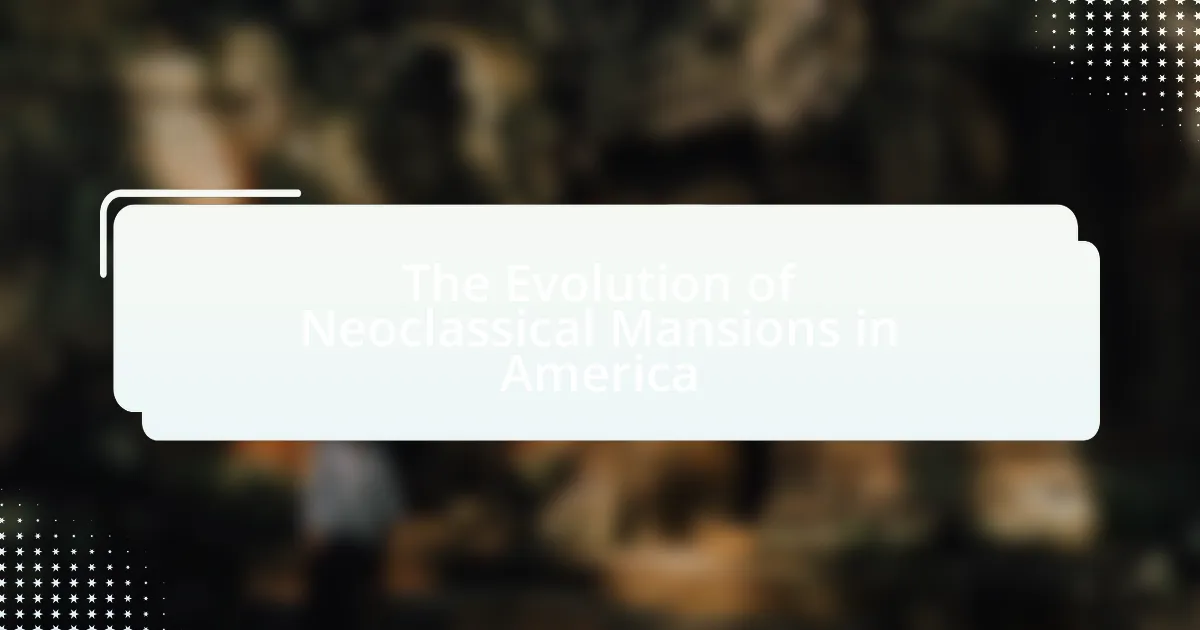Neoclassical mansions are large, stately homes in America that emerged in the late 18th and early 19th centuries, characterized by their grand architectural style inspired by ancient Greek and Roman designs. This article explores the historical context of Neoclassical architecture, its defining characteristics, and the influences that shaped its evolution, including the political and cultural climate of the time. It highlights notable examples of Neoclassical mansions, the role of prominent architects, and the significance of these structures in American culture and history. Additionally, the article discusses contemporary preservation efforts and best practices for maintaining these architectural landmarks.

What are Neoclassical Mansions and Their Historical Context?
Neoclassical mansions are large, stately homes characterized by their grand architectural style that draws inspiration from the classical art and architecture of ancient Greece and Rome. This architectural movement emerged in the mid-18th century and gained prominence in America during the late 18th and early 19th centuries, reflecting the nation’s aspirations for democracy and cultural sophistication. The design elements of neoclassical mansions often include symmetrical shapes, columns, and elaborate ornamentation, which symbolize power and stability. Notable examples include the Virginia State Capitol, designed by Thomas Jefferson, and the iconic Monticello, showcasing the influence of neoclassical ideals in American architecture. The historical context of neoclassical mansions is rooted in the Enlightenment, a period that emphasized reason, individualism, and a return to classical ideals, which resonated with the emerging American identity following independence.
How did Neoclassical architecture emerge in America?
Neoclassical architecture emerged in America during the late 18th century as a response to the desire for a national identity that reflected democratic ideals and classical heritage. Influenced by the Enlightenment and the architectural styles of ancient Greece and Rome, American architects sought to convey principles of order, symmetry, and proportion in their designs. Notable examples include the Virginia State Capitol, designed by Thomas Jefferson in 1785, which was inspired by the Roman Pantheon, and the Massachusetts State House, completed in 1798, showcasing the adoption of classical elements. This architectural movement was further popularized by the publication of design books, such as those by Andrew Jackson Downing, which promoted Neoclassical aesthetics in residential architecture, leading to the widespread construction of Neoclassical mansions across the country.
What influences shaped the Neoclassical style in American mansions?
The Neoclassical style in American mansions was shaped primarily by the influence of classical architecture from ancient Greece and Rome, as well as the Enlightenment ideals of order, symmetry, and proportion. This architectural movement emerged in the late 18th century, reflecting a desire for a return to the classical roots that emphasized rationality and beauty. Prominent figures such as Thomas Jefferson, who designed Monticello and the Virginia State Capitol, played a crucial role in popularizing Neoclassical elements, drawing inspiration from European architects like Andrea Palladio. The adoption of these classical elements in American mansions symbolized a cultural aspiration towards democracy and sophistication, aligning with the nation’s emerging identity during the post-Revolutionary period.
How did the political and cultural climate of the time affect architectural choices?
The political and cultural climate of the time significantly influenced architectural choices, particularly in the design of Neoclassical mansions in America. During periods of political stability and cultural flourishing, such as the post-Revolutionary War era, architects drew inspiration from classical Greek and Roman styles to symbolize democracy and civic virtue. This is evident in the use of columns, symmetry, and grand facades, which reflected the ideals of Enlightenment thinking and national identity. For instance, Thomas Jefferson’s Monticello and the Virginia State Capitol showcase these architectural elements, embodying the aspirations of a young nation seeking to establish its identity through classical references. Additionally, the cultural emphasis on education and refinement during the early 19th century further propelled the adoption of Neoclassical designs, as affluent families sought to project their status and values through their homes.
What are the defining characteristics of Neoclassical mansions?
Neoclassical mansions are characterized by their grand scale, symmetry, and use of classical architectural elements. These structures often feature prominent columns, pediments, and elaborate cornices, reflecting the influence of ancient Greek and Roman architecture. The use of materials such as brick, stone, and stucco is common, along with large windows and doors that enhance the sense of openness and light. Additionally, Neoclassical mansions typically incorporate formal gardens and expansive grounds, emphasizing their status and elegance. This architectural style emerged in the late 18th century and became particularly popular in America during the early 19th century, as seen in notable examples like the Virginia State Capitol designed by Thomas Jefferson.
What architectural elements are commonly found in Neoclassical mansions?
Neoclassical mansions commonly feature elements such as grand columns, porticos, symmetrical facades, and elaborate cornices. These architectural components reflect the influence of classical Greek and Roman design, emphasizing proportion and harmony. For instance, the use of Corinthian or Ionic columns is prevalent, showcasing intricate detailing that enhances the mansion’s grandeur. Additionally, the symmetrical arrangement of windows and doors contributes to the overall balance of the structure, a hallmark of Neoclassical architecture. The presence of a central entrance, often accentuated by a pediment, further exemplifies the style’s adherence to classical principles.
How do these characteristics reflect the values of the era?
The characteristics of Neoclassical mansions reflect the values of the era by emphasizing ideals such as democracy, individualism, and classical education. These mansions often featured grand columns, symmetry, and elaborate facades, which symbolized the aspiration for a society rooted in Enlightenment principles. For instance, the use of classical architecture was a direct homage to ancient Greece and Rome, cultures that valued civic virtue and public life, aligning with the American pursuit of liberty and governance. Additionally, the spacious interiors and opulent materials showcased wealth and status, reflecting the era’s belief in the American Dream and the importance of personal achievement.

How did Neoclassical Mansions evolve over time in America?
Neoclassical mansions in America evolved significantly from the late 18th century through the 19th century, reflecting changes in architectural styles, cultural values, and social status. Initially inspired by ancient Greek and Roman architecture, these mansions featured grand columns, symmetrical shapes, and elaborate facades, as seen in Thomas Jefferson’s Monticello, completed in 1809. As the 19th century progressed, the style incorporated elements of the Gothic Revival and Italianate styles, leading to more ornate details and varied rooflines, exemplified by the design of the Rhode Island State House, completed in 1904. The evolution continued into the late 19th and early 20th centuries, where the Beaux-Arts style emerged, blending Neoclassical elements with more decorative features, as seen in the opulent mansions of the Gilded Age, such as the Vanderbilt Mansion in New York. This progression illustrates how Neoclassical mansions adapted to reflect the changing tastes and aspirations of American society over time.
What key periods mark the evolution of Neoclassical mansions?
The evolution of Neoclassical mansions is marked by three key periods: the early 18th century, the late 18th century to early 19th century, and the mid to late 19th century. The early 18th century saw the introduction of Neoclassical design in America, influenced by European styles, particularly from England and France. The late 18th century to early 19th century represented the peak of Neoclassical architecture, characterized by grand structures such as Thomas Jefferson’s Monticello, which exemplified the style’s emphasis on symmetry and classical elements. The mid to late 19th century marked a transition as the style evolved into the Beaux-Arts movement, incorporating more elaborate decorative features while still retaining Neoclassical principles.
How did the Federal period influence Neoclassical design?
The Federal period significantly influenced Neoclassical design by emphasizing symmetry, proportion, and the use of classical elements. This era, spanning from approximately 1789 to 1820, saw American architects and builders adopt and adapt European Neoclassical styles, particularly those inspired by ancient Greek and Roman architecture. Notable features included the use of columns, pediments, and decorative motifs such as garlands and urns, which were prevalent in Federal-style homes. The influence is evident in iconic structures like the Massachusetts State House, designed by Charles Bulfinch, which showcases the harmonious proportions and classical detailing characteristic of Neoclassical design.
What changes occurred during the Antebellum period?
The Antebellum period saw significant changes in architecture, particularly in the evolution of Neoclassical mansions in America. This era, spanning from the late 1820s to the onset of the Civil War in 1861, marked a shift towards grander and more elaborate designs influenced by classical Greek and Roman styles. The adoption of features such as porticos, columns, and symmetrical layouts became prevalent, reflecting the ideals of democracy and civic virtue associated with ancient civilizations. Notable examples include the construction of the Greek Revival style homes, which emphasized simplicity and grandeur, as seen in the works of architects like Robert Mills and Thomas Jefferson. These architectural transformations were not only aesthetic but also symbolized the growing wealth and aspirations of the American elite during this period.
What role did prominent architects play in this evolution?
Prominent architects played a crucial role in the evolution of Neoclassical mansions in America by designing iconic structures that embodied the principles of classical architecture. Architects such as Thomas Jefferson and Richard Morris Hunt were instrumental in popularizing Neoclassical styles, integrating elements like symmetry, grand columns, and elaborate facades into their designs. Jefferson’s Monticello and Hunt’s Biltmore Estate exemplify how these architects adapted European influences to create uniquely American interpretations of Neoclassicism, reflecting both cultural aspirations and the burgeoning national identity in the 18th and 19th centuries. Their works not only set architectural standards but also influenced subsequent generations of architects, solidifying Neoclassicism as a dominant style in American residential architecture.
Who were the leading architects of Neoclassical mansions in America?
The leading architects of Neoclassical mansions in America included Thomas Jefferson, Robert Mills, and Richard Morris Hunt. Thomas Jefferson is renowned for his design of Monticello, which exemplifies Neoclassical principles. Robert Mills, known for the Washington Monument, also designed several prominent Neoclassical buildings, including the U.S. Treasury. Richard Morris Hunt was influential in bringing the style to the Gilded Age, designing mansions such as the Breakers in Newport, Rhode Island. These architects significantly shaped the Neoclassical architectural landscape in America through their iconic designs and contributions.
What innovations did these architects introduce?
Architects of Neoclassical mansions in America introduced innovations such as the use of grand porticos, symmetrical facades, and the incorporation of classical elements like columns and pediments. These features were designed to evoke the grandeur of ancient Greek and Roman architecture, reflecting ideals of democracy and civic virtue. For instance, Thomas Jefferson’s Monticello exemplifies this with its harmonious proportions and use of the dome, which became a hallmark of American Neoclassical design. Additionally, the adaptation of local materials and the integration of modern amenities within these classical frameworks marked a significant evolution in residential architecture during this period.

What are some notable examples of Neoclassical Mansions in America?
Notable examples of Neoclassical mansions in America include the Virginia State Capitol in Richmond, designed by Thomas Jefferson, and the Marble House in Newport, Rhode Island, designed by Richard Morris Hunt. The Virginia State Capitol, completed in 1788, showcases classical elements inspired by Roman architecture, while Marble House, built between 1888 and 1892, exemplifies the opulence of the Gilded Age with its extensive use of marble and classical motifs. Other significant examples are the Andrew Jackson Downing House in Newburgh, New York, and the Astor Court in New York City, both reflecting the grandeur and symmetry characteristic of Neoclassical design.
Which Neoclassical mansions are considered iconic?
Iconic Neoclassical mansions include the Virginia State Capitol, designed by Thomas Jefferson, and the Monticello estate, also by Jefferson, which exemplifies Neoclassical architecture in America. Additionally, the Marble House in Newport, Rhode Island, designed by Richard Morris Hunt, showcases the grandeur of the style. These mansions are recognized for their classical elements, symmetry, and historical significance, reflecting the ideals of the Neoclassical movement in American architecture.
What features make these mansions stand out?
Neoclassical mansions in America stand out due to their grand architectural elements, including symmetrical facades, large columns, and elaborate cornices. These features reflect the influence of classical Greek and Roman architecture, emphasizing proportion and harmony. For instance, the use of porticos and pediments creates a striking entrance, while the incorporation of large windows enhances natural light and openness. Additionally, the use of high-quality materials such as marble and limestone adds to their luxurious appeal, exemplified by iconic structures like the Virginia State Capitol designed by Thomas Jefferson.
How do these examples reflect the broader trends in Neoclassical architecture?
The examples of Neoclassical mansions in America reflect broader trends in Neoclassical architecture through their emphasis on symmetry, grandeur, and the use of classical elements such as columns and pediments. These architectural features align with the movement’s revival of ancient Greek and Roman styles, which sought to convey ideals of democracy, order, and beauty. For instance, the prevalence of porticos and the use of white marble in these mansions illustrate the trend of adopting monumental forms that symbolize power and stability, mirroring the architectural practices seen in prominent European structures of the same period. Additionally, the incorporation of elaborate ornamentation and balanced proportions in these examples showcases the Neoclassical focus on harmony and elegance, further solidifying their connection to the broader architectural movement.
What is the significance of these mansions in American culture?
Neoclassical mansions hold significant cultural importance in America as symbols of wealth, power, and architectural sophistication. These structures reflect the aspirations of American society during the 18th and 19th centuries, showcasing a desire to emulate European grandeur while establishing a unique national identity. For instance, the design of Thomas Jefferson’s Monticello illustrates the influence of classical architecture on American ideals of democracy and enlightenment. Additionally, these mansions often served as cultural hubs, hosting social events that shaped community dynamics and contributed to the development of American social norms. The preservation of such mansions today highlights their role in understanding American history and heritage, as they provide insight into the lifestyles and values of past generations.
How do Neoclassical mansions contribute to our understanding of American history?
Neoclassical mansions significantly contribute to our understanding of American history by reflecting the cultural, social, and political values of their time. These structures, built primarily in the late 18th and early 19th centuries, embody the ideals of democracy and classical antiquity, which were influential during the formation of the United States. For instance, the design of Neoclassical mansions often incorporates elements from ancient Greek and Roman architecture, symbolizing the aspiration for a government based on reason and civic virtue.
Moreover, the construction of these mansions often indicates the wealth and status of their owners, providing insight into the economic conditions and social hierarchies of the period. Historical examples, such as the Virginia State Capitol designed by Thomas Jefferson, illustrate how Neoclassical architecture was used to convey national identity and values. Thus, Neoclassical mansions serve as tangible representations of the evolving American narrative, encapsulating the intersection of art, politics, and society throughout history.
What role do they play in contemporary society and preservation efforts?
Neoclassical mansions play a significant role in contemporary society by serving as cultural landmarks and symbols of historical architectural styles. These structures contribute to the preservation of American heritage, attracting tourism and educational opportunities that foster appreciation for historical craftsmanship. For instance, organizations like the National Trust for Historic Preservation actively work to protect and restore these mansions, emphasizing their importance in understanding America’s architectural evolution and social history. The preservation of neoclassical mansions not only maintains aesthetic value but also supports local economies through heritage tourism, demonstrating their multifaceted impact on society today.
What are the best practices for preserving Neoclassical mansions today?
The best practices for preserving Neoclassical mansions today include regular maintenance, historical research, and using appropriate materials for restoration. Regular maintenance involves inspecting and repairing structural elements, such as roofs and foundations, to prevent deterioration. Historical research ensures that restoration efforts align with the original architectural style and materials, preserving the mansion’s authenticity. Using appropriate materials, such as period-accurate paint and wood, maintains the integrity of the structure. These practices are supported by preservation guidelines from organizations like the National Trust for Historic Preservation, which emphasize the importance of authenticity and sustainability in restoration efforts.

Leave a Reply